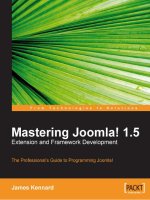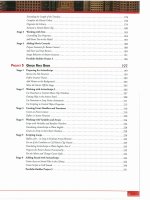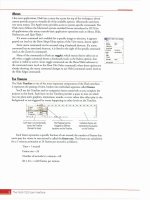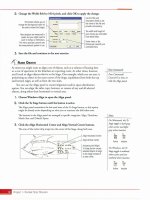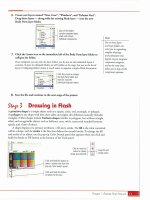The professional scrummasters handbook
Bạn đang xem bản rút gọn của tài liệu. Xem và tải ngay bản đầy đủ của tài liệu tại đây (11.75 MB, 336 trang )
www.it-ebooks.info
The Professional
ScrumMaster's Handbook
A collection of tips, tricks, and war stories to help
the professional ScrumMaster break the chains of
traditional organization and management
Stacia Viscardi
professional expertise distilled
P U B L I S H I N G
BIRMINGHAM - MUMBAI
www.it-ebooks.info
The Professional ScrumMaster's Handbook
Copyright © 2013 Packt Publishing
All rights reserved. No part of this book may be reproduced, stored in a retrieval
system, or transmitted in any form or by any means, without the prior written
permission of the publisher, except in the case of brief quotations embedded in
critical articles or reviews.
Every effort has been made in the preparation of this book to ensure the accuracy
of the information presented. However, the information contained in this book is
sold without warranty, either express or implied. Neither the author, nor Packt
Publishing, and its dealers and distributors will be held liable for any damages
caused or alleged to be caused directly or indirectly by this book.
Packt Publishing has endeavored to provide trademark information about all of the
companies and products mentioned in this book by the appropriate use of capitals.
However, Packt Publishing cannot guarantee the accuracy of this information.
First published: April 2013
Production Reference: 1120413
Published by Packt Publishing Ltd.
Livery Place
35 Livery Street
Birmingham B3 2PB, UK.
ISBN 978-1-84968-802-4
www.packtpub.com
Cover Image by Artie Ng ()
www.it-ebooks.info
Credits
Author
Proofreader
Stacia Viscardi
Jonathan Todd
Reviewers
Indexer
Lee Devin
Monica Ajmera Mehta
Steve Spearman
Graphics
Aditi Gajjar
Acquisition Editor
Erol Staveley
Production Coordinator
Lead Technical Editor
Neeshma Ramakrishnan
Technical Editors
Prachali Bhiwandkar
Aditi Gajjar
Cover Work
Jalasha D'costa
Aditi Gajjar
Ankita R. Meshram
Project Coordinator
Abhishek Kori
www.it-ebooks.info
www.it-ebooks.info
Foreword
I've known Stacia Viscardi for many years now, since the very beginning of my
connection with the Agile software world. In fact, Stacia introduced me to that
world and has guided me from (alas!) a distance ever since. I have marveled at her
knowledge, her skills, and (rare in her field) her sly and generous wit. She's plenty
nerdy, Stacia, but unlike most of her colleagues, she makes wonderfully unexpected
connections between this and that; connections that always illuminate all sides of
this, all the innards of that. These surprises, little time bombs of unforeseen pleasure,
make her writing exceptional in a field not known for wit or surprise.
Stacia doesn't browbeat you with erudition or intimidate you with exotica. She
simply sets her imagination to work on connections she sees that you may not have.
Or, if you have seen them, she shines her light on a different facet than the one you
may find familiar. That light has qualities rare in the software biz. It's warm, that
light. It invites you to join, to include, and to enjoy. It makes no pushy effort to
impress you with its brilliance. It illuminates her subject, the processes that create
that subject, and her idiosyncratic, persuasive take on it.
When you read this book, you'll find yourself in wonderful company. If you know
Stacia's work, this book will confirm your admiration and gratitude. If this book is
your introduction to her, brace yourself!
You're in for a treat!
Lee Devin
Consultant, AgileEvolution,
Senior Consultant, Innovation Practice Cutter Consortium
www.it-ebooks.info
About the Author
Stacia Viscardi is an Agile coach, Certified Scrum Trainer, and organizational
transformation expert, devoted to creating energized and excited teams that delight
their customers and inspire others. With humble beginnings in Port Arthur, Texas,
Stacia found her niche as a Manufacturing Project Manager in the early nineties; she
landed in the technology world in 1999 and never looked back. In 2003 she became
the sixty-second Certified ScrumMaster (there are now over 200,000!), and founded
AgileEvolution in 2006. She has helped companies such as Cisco Systems, Martha
Stewart Living, Primavera, DoubleClick, Google, Razorfish, MyPublisher, Washington
Post, and many others find their way to agility. Co-author of the Software Project
Manager's Bridge to Agility, Stacia has taught Agile in 17 countries and is active in the
ScrumAlliance as a CST and trusted community advisor. When she is not doing Agile
stuff, she is training for a marathon or other long race or spending cozy nights on the
sofa with her husband Chris, and dogs Jax and Cobi.
A self-proclaimed process nerd, she loves helping teams and organizations discover
the Scrum/XP/Lean mash-ups that enables focused, flexible, and fast delivery of
products. She created the blog HelloScrum to share knowledge, tips, and tricks with
Scrum practitioners, and co-founded KnowAgile, an Agile testing website.
Stacia has co-authored The Software Project Manager's Bridge to Agility with Michele
Sliger (2008, Addison-Wesley).
www.it-ebooks.info
Acknowledgment
Over the past decade, I have met thousands of people who are passionate about
finding new and exciting ways to work, people whose hearts are in their work
every day, where writing software and creating great products is not only the
company's lifeblood but also their own. These people work extremely hard, put in
many late nights, trudge through moments of trying frustration, and yet do it all
over again to bring awesome technologies to the everyday person. I am humbled
to have worked in their presence, and without them this book would not be possible.
A million thanks!
Chris, you are the best husband a girl could ever want. I knew so many years ago that
you were my one great true love in life. Thank you for being so supportive while my
head was stuck in this book for the past year.
I am so grateful to my grandparents for their infinite supply of support and love,
and to my parents for teaching me to be self-reliant, and for instilling a hard-nosed,
never-quit work ethic. Barbara and Tony, thank you for loving me and treating me
like family. Alicia, I couldn't imagine a greater sister—thank you for your support
and love. And Aunt Maureen—my other mother—to the moon and back!
I'd like to thank Ken Schwaber for teaching me true Scrum. It is something much
greater than I was capable of realizing so long ago; Lee Devin for being a great friend
and for helping me find my edge and coming to the realization that no, I do not want
to be an actor; Maria Thelin for her intelligence, friendship, and expert orienteering
instruction; Dr. Rafael Landaeta for support and great ideas; Karen Delfau for taking
a chance on me; and the CST and CSC community of brilliant and scandalous folks. I
owe many martinis to Steve Spearman (Agile coach extraordinaire!) and Lee (Master
Dramaturge), who worked those red pens through modifiers, tapeworms, and "izzes"
and challenged me to take command of my ideas. Immense thanks to Abhishek,
Neeshma, Erol, and many others at Packt who brought this book to life. I'm humbled
by the loyalty of my dogs, Cobi and Jax, who sat by my side through many days and
nights of typing, editing, and cursing. And finally, life wouldn't be worth living if
not for running on the trails, where I can clear my head and think fresh, where God
undeniably exists and always leads me to find myself.
www.it-ebooks.info
About the Reviewers
Lee Devin taught theater while doing a PhD at Indiana University (1958-62), then
at the University of Virginia (1962-66), Vassar College (1966-70), and Swarthmore
College (1970-2002). He's an Equity actor and has played leading roles in productions
from Shakespeare to Tennessee Williams. He has a residuals check from SAG in the
amount of $0.01, to commemorate a brilliant movie career. With Rob Austin of the
Copenhagen Business School he wrote Artful Making; What Managers Need to Know
about How Artists Work, published in 2003. Stanford University Press published
their next book, The Soul of Design: Harnessing the Power of Plot to Create Extraordinary
Products, about the aesthetics of special things (gadgets that are better somehow
than the sum of their parts would lead you to believe), in September of 2012. He and
Rob have written numerous articles, including (with Erin Sullivan) Ooops, which
appeared in the Wall Street Journal. Lee's a Senior Consultant in the Innovation
practice at the Cutter Consortium, for whom he wrote An Innovative Frame of Mind
and Planning to Get Lucky. He has taught many workshops at Agile meetings, Scrum
gatherings, and software conferences. He has collaborated on various projects with
Stacia Viscardi and Lyssa Adkins. He's also the Senior Dramaturg at the People's
Light and Theatre and currently at work on writing projects that interfere with his
trout fishing, and cause him to neglect his grandchildren.
I'd like to acknowledge the support, for my work on this book and
many other projects, of Lyssa Adkins, Stacia Viscardi, and Robert D.
Austin. And, in a class by herself, beloved wife, Abigail Adams.
www.it-ebooks.info
Steve Spearman is an Agile coach and trainer. He has 30 years of experience in
corporate software development settings including 20 years in a variety of leadership
roles. Steve has been a software developer, architect, project manager, and a senior
manager of teams encompassing all those areas. His enterprise experience includes
Bell Laboratories, Lucent, Avaya, and Cisco Systems.
Steve is now providing Agile-focused training and coaching to companies ranging
from late-stage startups to large corporations. Steve is associated with a number of
leading firms, such as AgileEvolution, SwiftAscent, and TekSystems.
Steve has a BA in Psychology and a Masters in Computer Science. His certifications
include: PMI-ACP, PMP, CSP, Certified Scrum Product Owner, Certified
ScrumMaster, and SAFe Program Consultant.
www.it-ebooks.info
www.PacktPub.com
Support files, eBooks, discount offers and more
You might want to visit www.PacktPub.com for support files and downloads related to
your book.
Did you know that Packt offers eBook versions of every book published, with PDF and ePub
files available? You can upgrade to the eBook version at www.PacktPub.com and as a print
book customer, you are entitled to a discount on the eBook copy. Get in touch with us at
for more details.
At www.PacktPub.com, you can also read a collection of free technical articles, sign up for a
range of free newsletters and receive exclusive discounts and offers on Packt books and eBooks.
TM
Do you need instant solutions to your IT questions? PacktLib is Packt's online digital book
library. Here, you can access, read and search across Packt's entire library of books.
Why Subscribe?
•
Fully searchable across every book published by Packt
•
Copy and paste, print and bookmark content
•
On demand and accessible via web browser
Free Access for Packt account holders
If you have an account with Packt at www.PacktPub.com, you can use this to access PacktLib
today and view nine entirely free books. Simply use your login credentials for immediate access.
Instant Updates on New Packt Books
Get notified! Find out when new books are published by following @PacktEnterprise on
Twitter, or the Packt Enterprise Facebook page.
www.it-ebooks.info
Table of Contents
Preface1
Chapter 1: Scrum – A Brief Review of the Basics
(and a Few Interesting Tidbits)
7
The problem
7
A brief history
8
The underlying concepts of Scrum
10
Complex adaptive systems
10
The empirical process control barstool
14
Scrum core values
15
Scrum is inherently lean
17
Scrum roles
18
Scrum team
18
Product owner
19
ScrumMaster19
Brief review of the Scrum framework
20
Sprint planning
20
Daily scrum meeting
21
Sprint review meeting
21
Sprint retrospective
22
Release planning (optional)
22
Scrum artifacts
22
The product backlog
23
The sprint backlog
24
The product increment
24
Visible progress
24
Release backlog and burndown
24
Sprint burndown
25
Dysfunctions or true constraints?
26
www.it-ebooks.info
Table of Contents
Is your team ready for Scrum?
Summary
Recommended reading
Chapter 2: Release Planning – Tuning Product Development
Start at the beginning – product backlog
Focus product backlogs on users and values
Engage the team early
Prioritization can be useful for other things
Release planning – when will you set your features free?
Timing of releases and release planning
Don't create the software big dig
Integrate early and often to mitigate risks
Make buffers visible
How to conduct a release planning event?
Do your homework!
Facilitating the release planning meeting
Release planning summary
Summary
Recommended reading
Chapter 3: Sprint Planning – Fine-tune the Sprint Commitment
Sprint planning basics
Preparing for sprint planning
High-octane stories
Help the product owner prepare for sprint planning
Physical space
Visualize the meeting
Scratchpad, script, and agenda
Running the sprint planning meeting
Part I – the What and the Why
Different types of stories
Part II – the How
27
27
28
29
32
34
36
37
39
39
40
40
41
44
45
46
54
55
55
57
57
60
60
61
62
63
65
67
67
69
70
Understanding capacity
70
73
Talk first, then identify sprint tasks
Anyone tasks, expert tasks, and pairing
74
76
Sprint buffering
It helps to see time
76
Team members should talk with each other
77
78
Don't over-facilitate
Sample sprint planning checklist
78
Commit!80
Improving sprint planning
Summary
Recommended reading
81
81
82
[ ii ]
www.it-ebooks.info
Table of Contents
Chapter 4: Sprint! Visible, Collaborative,
and Meaningful Work
How the Scrum team should work
Working in a sprint
Sprints shouldn't be just Sprints
Beware of the old mind-set creeping into the new paradigm
Estimating work
The misunderstood daily scrum meeting
Three questions
What did I do since yesterday's meeting?
What will I do by tomorrow's meeting?
What blocks me from being able to do my work?
Do we have to meet every day?
Who's allowed to attend the daily scrum?
Look ahead at the next sprint's product backlog items
It takes a village – communicating during the sprint
Individual influences to the work of the sprint
Factor 1 – Openness
Factor 2 – Conscientiousness
Factor 3 – Extroversion, are you an innie or an outie?
Factor 4 – Agreeableness
Factor 5 – Neuroticism
What's 'Norm'al for one team is not for another
A corporate culture and its impact on teamwork
Team assumptions about management
Corporate mind-set opposes the Agile manifesto
Fear of empowerment
Employees feel like headcount
Summary
Recommended reading
83
84
85
85
86
89
92
94
94
96
96
97
98
99
100
101
101
102
103
104
104
105
106
107
107
107
108
109
109
Chapter 5: The End? Improving Product
and Process One Bite at a Time
111
Set the context
Give a visual
Keep your stories straight
Keep everyone focused
Does a Scrum team demo incomplete work?
See the whole
118
118
119
120
120
121
Sprint review – inspecting and adapting the product
Product owner acceptance
Prior to the sprint review
During the sprint review
[ iii ]
www.it-ebooks.info
113
114
115
117
Table of Contents
Possible outcomes of a sprint review
Don't surprise the product owner
Sprint reviews for continuous flow frameworks
Sprint review – a time for collaboration and trust
Sprint retrospective – inspecting and adapting
processes and teamwork
SCRUM is not an acronym for Serious Crud
Required by Upper Management
Unearthing information for improvement
Set the safety
Recall sprint events
Ask – What worked well for us? What didn't work so well for us?
Who owns the improvement?
Prioritize and assign action items
Make REAL action items
Some different retrospective techniques
Change the scenery
Visualize the future
Team cave art
Retrospective yoga/meditation
Why should we care about reviews and retrospectives?
Summary
Recommended reading
Chapter 6: The Criticality of Real-time Information
Yesterday's news is old news
Getting the message
Through the Scrum microscope
1x magnification – product vision/initiatives
2x magnification – the product roadmap
4x magnification – the release plan
Release the burndown baseline
Baseline with updates
Team velocity chart
A Gantt chart in an Agile project
123
124
124
125
126
127
129
129
130
130
131
132
132
133
134
134
135
136
136
139
139
141
142
143
145
146
147
149
150
151
152
153
8x magnification – the product backlog
154
16x magnification – the sprint
155
32x magnification – tasks, daily scrums, and other information
158
What does your user want?
User stories in sprint planning
Acceptance criteria
Definition of Done
Sprint goals
Sprint reviews
Daily broadcasts
Daily scrums
[ iv ]
www.it-ebooks.info
154
155
156
157
157
158
158
158
Table of Contents
Sprint backlogs
Sprint burndown chart
What burns down can also burn up
64x magnification – read all about it, in the team room!
Monitor this!
Scrum microscope summary
When physical taskboards and conversations aren't enough
Invite stakeholders to sprint reviews
Create and distribute reports
Waste and obstacle removal
Summary
Chapter 7: Scrum Values Expose Fear,
Dysfunction, and Waste
Prepare for change aches and pains
The five core values of Scrum
Scrum value #1 – Courage
Free the spark
Scrum value #2 – Commitment
Commitment exposes fear of dedicated,
cross-functional Scrum teams
What do we do about commitment issues?
159
160
163
164
165
165
167
168
168
169
173
175
176
178
181
181
182
184
190
Scrum value #3 – Openness
191
Scrum value #4 – Focus
197
Scrum value #5 – Respect
200
Secrecy and what to do about it
Openness exposes truth about capacity and demand
Openness exposes a need for slowing down in order to eventually speed up
Lack of focus and personal control = missed commitments
Focus reveals waste
Focus reveals failure to understand small increments
Power, position, and control and what to do about it
Summary
Recommended reading
Chapter 8: Everyday Leadership for
the ScrumMaster and Team
Everyday leadership
First, what kind of personality do you have?
Learn to look into your reflection
Portrait of a leader
Selfless, confident, and accountable
Open to feedback
Builds trust
[v]
www.it-ebooks.info
192
193
196
198
199
199
201
202
202
203
203
205
206
209
209
210
210
Table of Contents
Leads with Theory Y
211
Honest212
How to become a better ScrumMaster
212
Empower yourself and others!
213
Help others visualize the desired state
214
216
Influence others
Roll up your sleeves and servant-lead
218
218
Listen more than talk
Plant seeds
219
Choose to be happy, focus on the positive
220
221
Know your communication style
Loud or quiet?
221
Direct versus passive
222
Switzerland or Supreme Court judge
223
Other ScrumMaster characteristics
224
Procrastinator or proactive
224
Teacher225
Student225
Scrum buddy
226
Journal/walk up a hill
226
Which ScrumMaster persona are you?
226
Techie Taj
226
Bossy Betty
227
Clammed Up Carl
227
Thundering Thea
228
Officer Sophie
228
Summary
229
Recommended reading
229
Chapter 9: Shaping the Agile Organization
Will Agile cause a ripple, or a tsunami?
How does your organization measure up to the Scrum values?
What if the Scrum values score is low?
Culture change requires a multi-faceted approach
Illustrating the need for and direction of change
Pre-agility survey
Waste score
Old-fashioned interviews
The Agile organization chart and roles matrix
Traditional roles in an Agile organization
Scaling an Agile mind-set
[ vi ]
www.it-ebooks.info
231
232
234
235
236
236
237
238
239
239
241
241
Table of Contents
Self-actualizing individuals create an Agile organization
Goals and metrics that motivate self-actualizing
242
243
Don't go it alone
Avoiding Scrum as a panacea
Why change? What blocks?
Immunity to change
Face it, Scrum might not be for your organization
Summary
Recommended reading
248
249
250
251
251
252
252
Person has a say in it
Understanding what demotivates
Standardizing measurements
Frequent, multi-perspective feedback
CEO scorecard
Chapter 10: Scrum – Large and Small
Scrum stops the resource shell game
Small Scrum
Big programs, small Scrum
When Scrum gets big—dysfunction or constraint?
Challenge 1: Fearful ScrumMasters
Challenge 2: Late integration
Challenge 3: Communication across multiple teams
Challenge 4: Big picture metrics
243
244
245
246
247
253
254
255
256
257
258
259
260
261
Customer happiness
264
Time to Market
264
Quality264
Employee morale
264
Challenge 5: Not done – the root of all evil
Challenge 6: Too few product owners
Challenge 7: Scaling too much, too fast
Challenge 8: Wrong team structure
Challenge 9: Distributed teams
A real need for a project Grand Poobah
More tips for large Scrums
Agile DNA
Summary
Recommended reading
Chapter 11: Scrum and the Future
A leaner Agile Manifesto
Redefining the role of the organization
Self-managing teams – the inmates run the asylum!
Career paths
[ vii ]
www.it-ebooks.info
265
267
268
269
270
271
273
273
274
275
277
278
279
280
281
Table of Contents
True visibility
Capacity, not projects
The CEO of Me
Customer collaboration via prioritized product backlog
Don't squeeze innovation out of the product backlog
Regular product reviews or demos
We are all ScrumMasters
Appendix A: The ScrumMaster's Responsibilities
282
282
283
283
284
289
289
291
The ScrumMaster's role
291
Core knowledge
292
Responsibilities292
Running the sprint
Assisting the product owner
Creating a high-performing Scrum team
Making progress visible
Supporting and living the Scrum core values
Educating others
Improving personal skills and characteristics
293
294
294
295
296
296
297
Appendix B: ScrumMaster's Workshop
299
Chapter 1: Scrum – A Brief Review of the Basics
(and a Few Interesting Tidbits)
Chapter 2: Release Planning – Tuning Product Development
Chapter 3: Sprint Planning – Fine-tune the Sprint Commitment
Chapter 4: Sprint! Valuable, Collaborative, and Meaningful Work
Chapter 5: The End? Improving Product and
Process One Bite at a Time
Chapter 6: The Criticality of Real-time Information
Chapter 7: Scrum Values Expose Fear, Dysfunction, and Waste
Chapter 8: Everyday Leadership for the ScrumMaster and Team
Chapter 9: Shaping the Agile Organization
Chapter 10: Scrum – Large and Small
Index
[ viii ]
www.it-ebooks.info
299
300
301
302
303
304
305
307
308
308
309
Preface
Technical projects are like an old horse I had when I was a kid; they'll flip you
when you least expect it! Yet the element of surprise is actually a surety in our
technical world. Agile methods, with their focus on helping teams deliver quality
features and products quickly and flexibly, have drawn me in as a way to help
tame the bucking horse, the element of surprise in technical projects, and Scrum,
in particular, as a gateway to discover which day-to-day processes and working
styles fit best for a particular team in a particular setting.
A ScrumMaster, like a good rider, must know when to go easy on the horse, when
to use the spur, when to pull the reins, and when to just hang up the bridle and
put the saddle away for the day. There are nearly a quarter million CSMs now, and
many more to follow. While this is great news and represents a steady interest in
Agile methods, we are in the soup. There is rampant misuse and misunderstanding
of Scrum, which diminishes and possibly eliminates the amazing possibilities that
people discover by using it correctly. I've observed too many examples of good
Scrum gone bad—times in which tough, courageous, persistent ScrumMasters
could have really made a difference, but didn't; times when product owners could
have been a bit more involved; times when teams hid poor quality and shouldn't
have. Additionally, with the advent of several newer methods, the terms Iteration
Manager and Agile Master are floating around and representing an increasingly
watered-down, dangerous version of what the true ScrumMaster was meant to do.
That sucks, and makes me sad—and spurs me to action. I don't want the original
vision for ScrumMaster to become lost in the methodology/certification wagon
train; I want people to reach their full potential and believe that Scrum is one way
to facilitate that.
www.it-ebooks.info
Preface
Scrum is a simple process and it will not fail; you'll become extremely knowledgeable
about this by the end of the book. Yet it becomes the butt of the failure because it's
just too hard sometimes for people to accept responsibility. In other words, the horse
bucked, so it's easiest to just blame the horse! But maybe it was a rock in the hoof,
or a burr under the saddle—maybe there was another explanation or reason for the
undesirable behavior. A good ScrumMaster pokes and prods to find the real source for
organizational saddle burrs—and works diligently to pluck them out to make things
more comfortable.
My utopia is a world in which everyone in technology has the ScrumMaster
mind-set—whether they are team members, the named role of ScrumMaster, a
line manager, or an executive. That's probably not realistic, at least for now, so
luckily we have this very special role called the ScrumMaster to help others along.
A professional ScrumMaster willingly accepts the role, realizes that he/she must
help create an eager trial-and-error mind-set within the team and beyond, keep
bad habits in check, and let the best working patterns and styles emerge. This is an
extremely challenging, uphill both ways, in the snow, knee-deep journey. Sharp
ScrumMastering is so much more than running a daily Scrum meeting with a team;
using Scrum the right way can help a company do the right things and do them
quickly (which is the definition of Agile, after all).
Scrum is not something to transition TO; rather, it is something to transition
THROUGH. Through to what, exactly? Well, you will discover the answer when
you do it. Some teams realize that they like to throw in some Extreme Programming
practices, others find Kanban concepts to really help them out. Over time, you want
to help the team and organization create a process that works for them, and not the
other way around. As you become more aware of the wonderful ideas from other
Agile/Lean methods, you'll realize that what you call it—the names of methods or
frameworks—don't matter nearly as much as results. Keep your eye on helping
your team deliver in a fast, focused, yet flexible manner, and you're well on your
way. Scrum can help you get a nice running start.
I want you to become the Olympic-dressage-rider-on-a-Friesian kind of ScrumMaster,
not atop-a-Shetland-pony-being-led-around-a ring version (henceforth known as a
ScrumPuppet). You should know that you have more power than you probably give
yourself credit for. One person—you—can make a difference, and creating just one
successful Scrum team can change your organization. If you choose to accept this
mission, get ready for the ride of your life.
[2]
www.it-ebooks.info
Preface
What this book covers
Chapter 1, Scrum – A Brief Review of the Basics (and a Few Interesting Tidbits), provides
you with the history, philosophies, and practices of Scrum. If you're new to Scrum,
you must read this chapter; and if you're experienced, read it anyway. This chapter
contains the underlying reasons why this Scrum thing works. This and subsequent
chapters also have a Recommended Reading section with some of my favorite websites
and books for you to check out.
Chapter 2, Release Planning – Tuning Product Development, will help you help your
product owner prepare the product backlog for various planning uses, while we
focus on release planning specifically at this point. This chapter provides you with
preparation and facilitation tips to have you up and running a release planning
session in no time.
Chapter 3, Sprint Planning – Fine-tune the Sprint Commitment, suggests ways for you
to envision, prepare, and facilitate sprint planning meetings, but more importantly,
how to set your team up for success in a sprint.
Chapter 4, Sprint! Visible, Collaborative, and Meaningful Work, gets into the heart of the
sprint—what happens day to day, how team members should work together, and
how you can clear the path for team productivity. And what about that pesky daily
Scrum? Yep, we get into that too!
Chapter 5, The End? Improving Product and Process One Bite at a Time, suggests
that what you consider the end of a sprint is really only a pause that sets up the
beginning of the next. Learn how sprint reviews and retrospectives help teams
build trust with business stakeholders, and learn how retrospectives build a team.
Chapter 6, The Criticality of Real-time Information, presents ideas for giving visibility
to your team's work so that the product owner and other business stakeholders can
make smart decisions. You'll learn how to help the right people look through the
lenses of the Scrum microscope so that they may make smart and timely decisions.
Chapter 7, Scrum Values Expose Fear, Dysfunction, and Waste, walks you through the five
core values of Scrum and the top five responses of reluctant teams and organizations.
Chapter 8, Everyday Leadership for the ScrumMaster and Team, gives ideas and tips for
you to hone your personal skills in order to make your team as strong as it can be.
This is preparation for Chapter 9, Shaping the Agile Organization.
[3]
www.it-ebooks.info
Preface
Chapter 9, Shaping the Agile Organization, expands on Chapter 8, Everyday Leadership for
the ScrumMaster and Team, by turning your attention to the organization outside the
team. We'll explore motivation for knowledge workers, HR carrots and sticks, Agile
organizational structures, and the like.
Chapter 10, Scrum – Large and Small, gives you some ideas for scaling the Scrum
framework to accommodate larger multi-team programs. We'll also delve a little into
distributed teams.
Chapter 11, Scrum and the Future, will take you on a journey to the future world of
knowledge work, what organizations will look like, and how, if done with serious
professionalism, ScrumMasters can make that happen sooner rather than later.
Appendix A, ScrumMaster's Responsibilities, provides a run-down of ScrumMaster
responsibilities and duties. You can use this list as a quick way to stock your
Impediment Backlog.
Appendix B, ScrumMaster's Workshop, is full of thought-provoking questions,
scenarios, and exercises—broken out by chapter—for you to work through and think
about while reading the book. This appendix is also available online for download
at />scrum_master_workshop.pdf.
I created a companion website, www.helloscrum.com, to provide you with more
ideas, tips, and tricks to help you along your way.
A few images used in this book have been purchased from iStockPhoto.
What you need for this book
This is not a technical book with code snippets and scripts and such. But you still
need to bring some things to the table while reading it: courage, open-mindedness,
honesty, and a willingness to take a hard look at yourself and your organization
with the goal of identifying room for improvement. Please leave the vanity at home.
[4]
www.it-ebooks.info
Preface
Who this book is for
This book is primarily for practicing ScrumMasters, who need help and new
ideas to bring their teams and organizations to the next level.
Conventions
In this book, you will find a number of styles of text that distinguish between
different kinds of information. Here are some examples of these styles and an
explanation of their meaning.
Warnings or important notes appear in a box like this.
Tips and tricks appear like this.
Reader feedback
Feedback from our readers is always welcome. Let us know what you think about
this book—what you liked or may have disliked. Reader feedback is important for
us to develop titles that you really get the most out of.
To send us general feedback, simply send an e-mail to ,
and mention the book title via the subject of your message.
If there is a topic that you have expertise in and you are interested in either writing
or contributing to a book, see our author guide on www.packtpub.com/authors.
Customer support
Now that you are the proud owner of a Packt book, we have a number of things to
help you to get the most from your purchase.
[5]
www.it-ebooks.info
Preface
Errata
Although we have taken every care to ensure the accuracy of our content, mistakes
do happen. If you find a mistake in one of our books—maybe a mistake in the text or
the code—we would be grateful if you would report this to us. By doing so, you can
save other readers from frustration and help us improve subsequent versions of this
book. If you find any errata, please report them by visiting ktpub.
com/submit-errata, selecting your book, clicking on the errata submission form link,
and entering the details of your errata. Once your errata are verified, your submission
will be accepted and the errata will be uploaded on our website, or added to any list of
existing errata, under the Errata section of that title. Any existing errata can be viewed
by selecting your title from />
Piracy
Piracy of copyright material on the Internet is an ongoing problem across all media.
At Packt, we take the protection of our copyright and licenses very seriously. If you
come across any illegal copies of our works, in any form, on the Internet, please
provide us with the location address or website name immediately so that we can
pursue a remedy.
Please contact us at with a link to the suspected
pirated material.
We appreciate your help in protecting our authors, and our ability to bring you
valuable content.
Questions
You can contact us at if you are having a problem
with any aspect of the book, and we will do our best to address it.
[6]
www.it-ebooks.info


